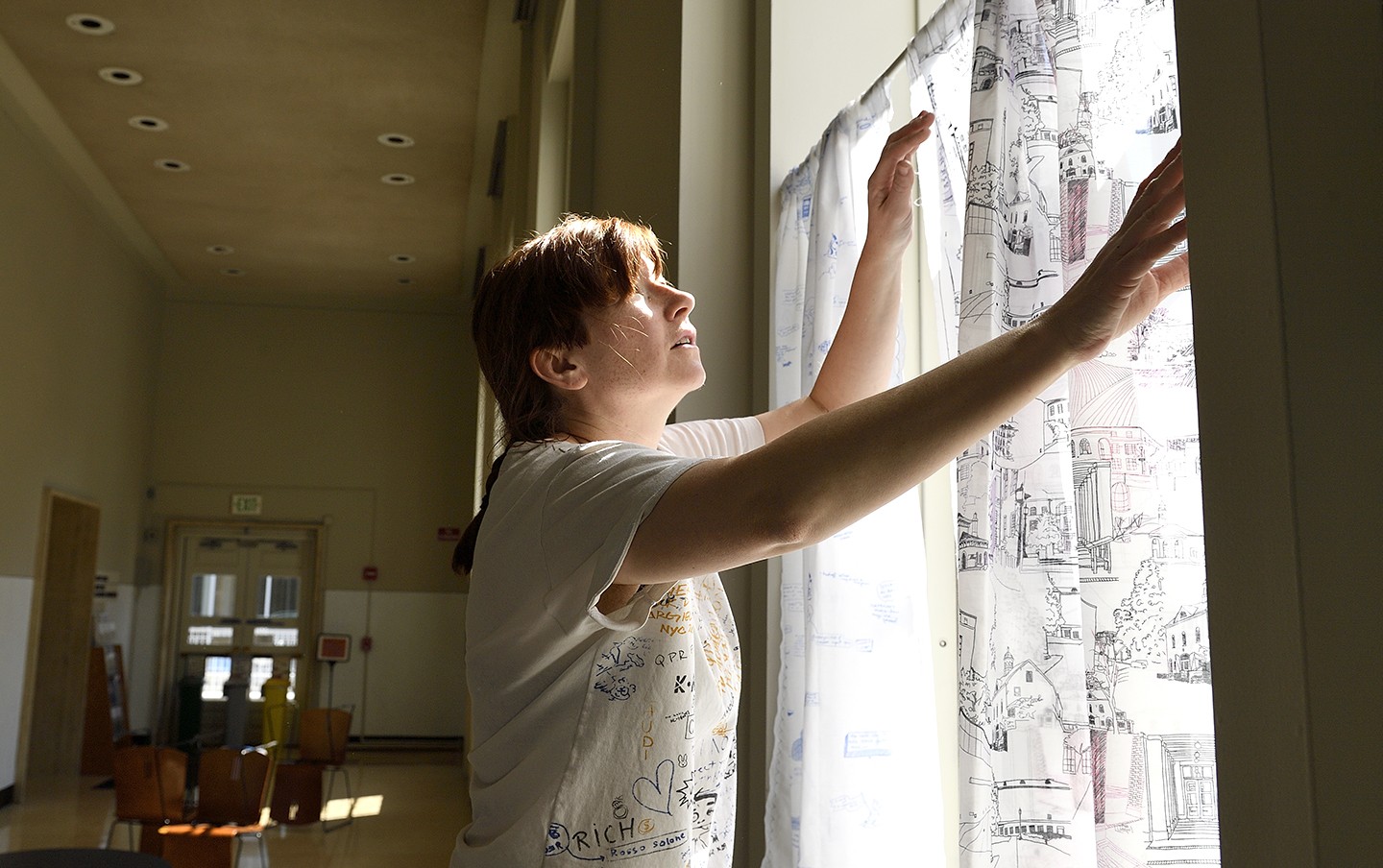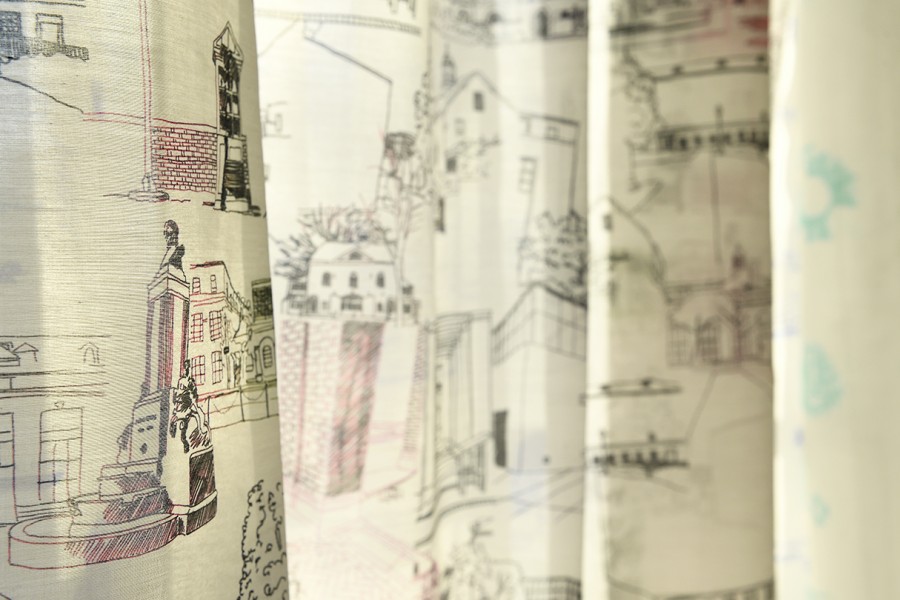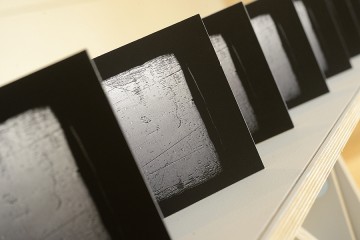Writing on the walls of the Milton S. Eisenhower Library is usually forbidden. But starting this week, visitors to the Q-level gallery are being encouraged to leave their own marks there as part of a unique, interactive exhibit that brings together the often disparate worlds of engineering and art.
Called "The Curse of Dimensionality," the exhibit, comprising 750 square feet of wallpaper and curtains, invites visitors to scratch off a light layer of white paint to reveal intriguing patterns and images on digitally printed wallpaper underneath. The display is based on months that artist and creator Kimberly Hall spent in the laboratories, classrooms, and hallways of the Hopkins Extreme Materials Institute, or HEMI, observing, taking notes, and sketching as both researchers and students tackled the challenge of understanding how materials respond under extreme stress.
A professor at the Maryland Institute College of Art, Hall came to the Homewood campus as part of the HEMI/MICA Extreme Arts Program, which unites faculty and students from both institutions to examine data, interpret outcomes, and translate results from extreme events in new ways.

Image caption: Artist Kimberly Hall, a professor at the Maryland Institute College of Art, created the exhibition as part of her residency with the HEMI/MICA Extreme Arts Program.
Image credit: Will Kirk / Johns Hopkins University
During her months as artist in residence at HEMI, Hall, who co-owns a Philadelphia design studio called Nottene, worked with the research team led by Lori Graham-Brady, a civil engineering professor and associate director of HEMI. Graham-Brady's group models (among other things) materials with random microstructures. One day while observing the research group, Hall heard someone use the term "the curse of dimensionality" and was instantly intrigued. It refers to phenomena that arise when analyzing and organizing data in high-dimensional spaces (often with hundreds or thousands of dimensions) that do not occur in low-dimensional settings such as the everyday world's three-dimensional physical space.
Hall said she was "deeply impressed" with the terminology used within the group, and the researchers' language and processes became a foundation for her project.
"When I saw Dr. Graham-Brady's list of projects and the way she wrote about them, I thought, 'This is so cool!' She talked about randomness and she talked about materials in a way that I could connect to," Hall said.
Hall hopes that by interacting with the piece, visitors will experience the roles of both artist and researcher. She has introduced random elements into the design, not only challenging conventional ideas about wallpaper design's predictability and pattern but also mirroring the unpredictability of research discovery. Scratching off the wallpaper's surface reveals hand-drawn vignettes of scenes from around the Homewood campus, as well as from Graham-Brady's research group. In fact, the instructions on the exhibit state: "You are invited to unveil a new work, created through collaboration, which is wholly dependent on your engagement."
Graham-Brady said that the artist-engineering collaboration was enlightening for all involved, helping each party look at the world through a different lens.

Image caption: The exhibit features digitally printed wallpaper created by Hall and then covered by white paint. Visitors are invited to scratch away the paint to reveal the images hidden beneath.
Image credit: Will Kirk / Johns Hopkins University
"[Kim] was really fascinated by the language of equations and that, for us, a bunch of seemingly random Greek symbols indicates something real," Graham-Brady said. "Whereas for her, the language is much more visual and emotional, which is not something we are as comfortable with in the science and engineering realm."
Anindya Bhaduri, a civil engineering graduate student in Graham-Brady's group, said that working with Hall and watching how the artist tackled the research led the team in a new direction.
"It didn't come directly from her work," Bhaduri said, "but it was definitely motivated by what she's doing, which is pretty awesome."
Hall admits to some trepidation about how the exhibit will actually work out but says she was inspired by the HEMI researchers, who understand that failure is an expected part of the scientific process.
"This project is very challenging because it's hard to know how the materials will work on this large scale," she said. "The materials were tested and tried out in our studio, but there's no way of knowing how they will react in such a large space and with such a large population interacting with them. But one of the things I keep talking about admiring in the scientists and researchers I worked with is their bravery and openness to the chance of failure. I hope I'm doing them justice with this work."
Hall is the HEMI/MICA Extreme Arts Program's second artist in residence—photographer Jay Gould completed his residency in 2016. The program also provides summer internships for students and this year has offered interactive workshops on the Homewood campus, led by MICA professors with funding from the Andrew W. Mellon Foundation.
"The Curse of Dimensionality" opens Thursday at MSE Library and runs through May 19.
Posted in Arts+Culture
Tagged visual art, johns hopkins extreme materials institute









